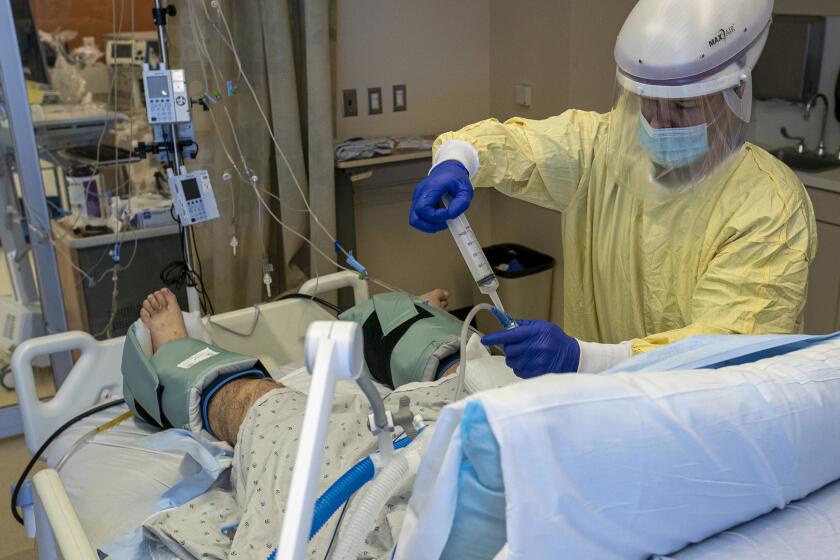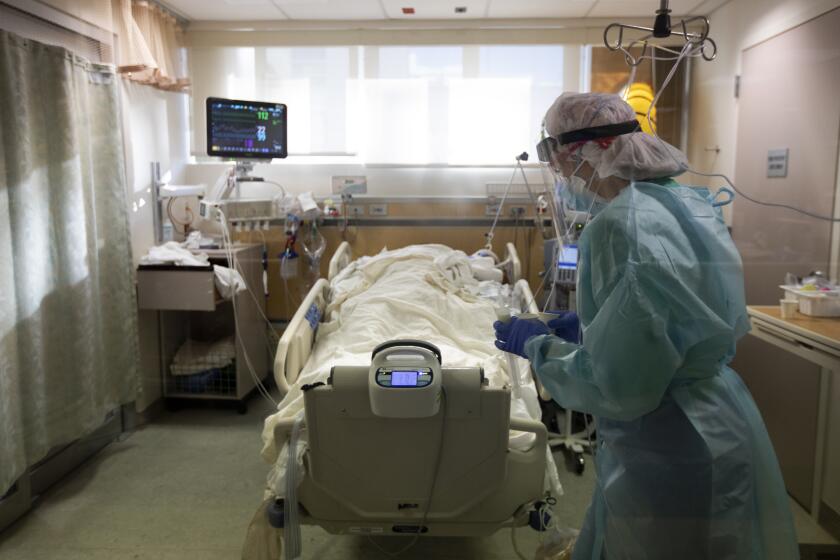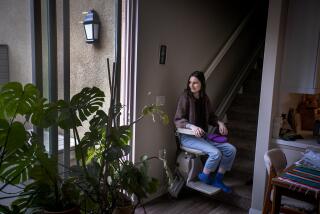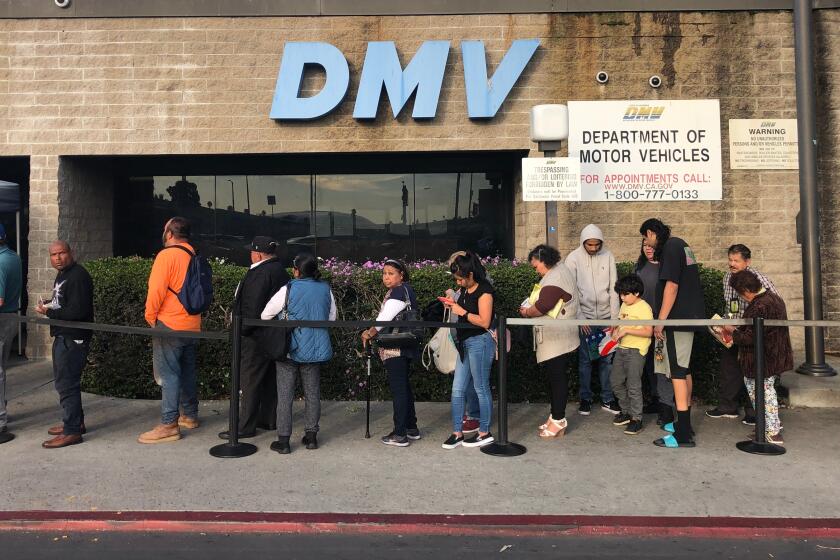Many COVID-19 ‘long haulers’ battle for disability benefits, adding insult to injury
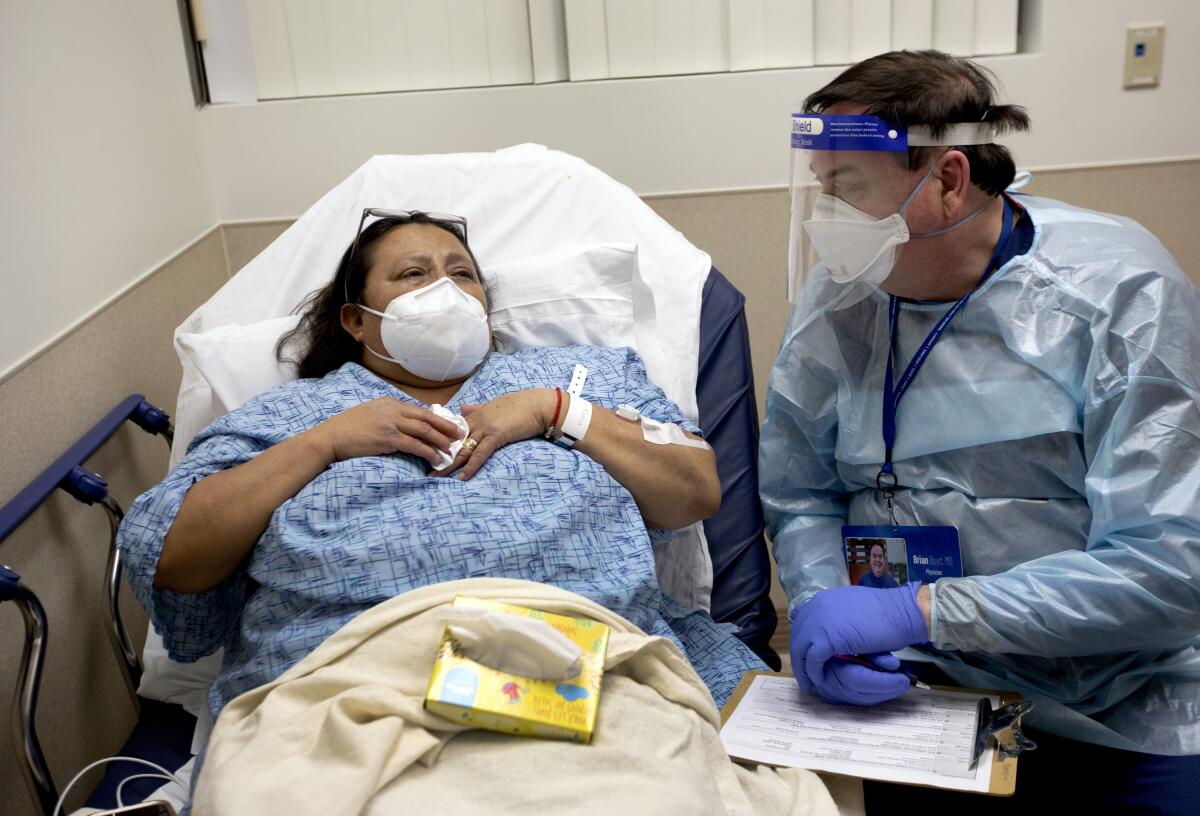
- Share via
Rickie Andersen took a brief break from work in March 2020 after she fell ill. Her cough, fever and chills were typical COVID-19 symptoms, but coronavirus tests were so scarce she could not obtain one to confirm the diagnosis.
After Andersen returned to her job as an information systems project manager in the San Francisco Bay Area, she struggled with profound fatigue, cognitive difficulties and other disabling complaints. For six months, she tried to keep awake during meetings and finish basic tasks that took much longer than before.
Finally, she decided to retain legal help so she could take advantage of the disability insurance coverage offered as an employee benefit. “I realized this is not going to be a short-term thing,” Andersen said.
Hundreds of thousands of people around the world are experiencing what is being called “long COVID” — a pattern of prolonged symptoms following an acute bout of the disease. Many have managed to continue working through accommodations like telecommuting, cutting down on hours and delegating responsibilities.
Others have found it impossible to fulfill their professional obligations and are making the tough decision to stop working and seek disability benefits. But as they pursue the application process, they are discovering a particular set of challenges.
Given the lack of testing in the first months, many “long haulers,” like Andersen, have no laboratory proof of infection. While antibody tests can provide such evidence, their accuracy varies. Moreover, many of the reported symptoms, including fatigue and cognitive impairment, are subjective and not clearly linked to specific organ damage.
‘I realized this is not going to be a short-term thing.’
— Rickie Andersen, San Francisco tech worker afflicted by COVID-19
Beyond that, compiling a thorough record for a disability application and navigating the bureaucratic hurdles require sustained brain power, something many long-haul patients can no longer muster. Barbara Comerford, a New Jersey disability lawyer, said she received dozens of inquiries starting last fall from long haulers seeking advice on filing for disability and often citing what is being called “brain fog” as their main complaint.
“Most are people calling to say, ‘I thought I could do it. I can’t. My mind doesn’t function for more than really brief periods of time,’” Comerford said. She gave a presentation to the New Jersey State Bar Assn. in mid-February on how to develop evidence for such cases.
In the U.S., close to 30 million people have tested positive for the coronavirus, although many cases of infection are asymptomatic. What proportion might be affected by long-term illness isn’t known. Scientific understanding of the phenomenon is in its infancy.
In January, The Lancet reported that around three-quarters of more than 1,700 COVID-19 patients who had been hospitalized in Wuhan, China, reported at least one ongoing symptom six months later. More recently, investigators from the University of Washington reported in JAMA Network Open that around 30% of 177 patients who had tested positive for the coronavirus still reported symptoms when they were surveyed one to 10 months later.
The Social Security Administration provides long-term disability to American workers who qualify under its strict criteria, but applicants often get turned down on the first try. A few states, including California and New York, provide short-term disability benefits, in some cases for up to a year.
The pandemic threatens to strike Social Security’s disability program and its beneficiaries in multiple ways that play into the system’s weaknesses.
Tens of millions of Americans also have private disability coverage, most often as part of their employment benefit packages.
The maximum currently available to an individual through the Social Security Disability Insurance program is just over $3,000 a month. A typical private long-term disability plan might cover 60% of a beneficiary’s base salary, with a much higher maximum amount.
Sandy Lewis, a pharmaceutical industry researcher, fell ill last March with what she assumed was COVID-19. She recovered but relapsed in April and again in May.
Through her employer-based insurance coverage, she received short-term disability for November and December, but the insurer, Prudential Financial, rejected her request for an extension. Soon after, she was diagnosed with myalgic encephalomyelitis/chronic fatigue syndrome, or ME/CFS, a debilitating illness that can be triggered by viral infections.
Lewis, who lives outside Philadelphia, is planning to appeal Prudential’s rejection of the short-term extension and apply for long-term disability. But the matter is unlikely to be resolved before fall. The situation has left her feeling “devastated,” she said, and in serious financial distress.
“This has been such an arduous journey,” she said. “I have no income and I’m sick, and I’m continuing to need medical care. I am now in a position, at 49 years old, that I may have to sell my home during a pandemic and move in with family to stay afloat.”
In Lewis’ case, a Prudential reviewer noted that her symptoms were “subjective” and that there were “no physical exam findings to correlate with any ongoing functional limitations,” according to Cassie Springer Ayeni, an Oakland disability lawyer who is representing her as well as Andersen.
Prudential would not comment on a specific case. Evan Scarponi, chief claims officer, said in a statement that “our collective understanding of COVID-19 and any associated long-term effects are still evolving” but that Prudential is “well-versed in evaluating both subjective and objective aspects of disability claims.”
Lawyers and advocates in the field expect the numbers of COVID-related long-term disability applicants to rise this year. But it’s still too soon to detect any such increase, said a spokesperson for the American Council of Life Insurers, a trade association. Workers typically must be unable to work for half a year before becoming eligible for long-term disability benefits, and applying can itself be a lengthy process.
Brian Vastag, a former Washington Post science and health reporter with ME/CFS, stopped working in 2014 and then sued Prudential after it rejected his long-term disability claim. Insurance companies, he said, can easily find reasons to dismiss applications from claimants with chronic illnesses characterized by symptoms like fatigue and cognitive impairment.
“The insurance companies will often say, ‘There’s no objective evidence, so we have nothing to support your claim,’” said Vastag, who won his case against Prudential in 2018. “I’m worried about the long COVID patients who can’t work anymore.”
Claimants can appeal a rejection. If the insurer rejects the appeal, claimants have the right to sue, as Vastag did. However, most such cases fall under the Employee Retirement Income Security Act of 1974. Because this federal law requires a losing insurer to pay the unpaid claims but does not provide for punitive or compensatory damages, critics argue it incentivizes the denial of coverage.
COVID-19 patients who take months to overcome their coronavirus infections despite treatment can become incubators of dangerous new strains.
In the event of litigation, the court’s role is to assess the already existing evidentiary record. That means it is essential to present a robust case in the initial application or during the administrative appeal before any litigation begins, said Ayeni, the disability lawyer for Andersen and Lewis.
“It’s the only shot to build a record for the courts, to develop a full body of evidence,” she said.
However, a successful disability case ultimately depends on documenting inability to work, not on obtaining a specific diagnosis. To augment the medical evidence, Ayeni often sends clients for neuropsychological testing, investigations of lung function and other specialist assessments. She also gathers affidavits from family members, professional colleagues and friends to confirm patients’ accounts.
In Andersen’s case, the strategy worked. Recognizing how complicated the application process was likely to be, she sought legal help early on. The insurer contracted by her employer approved her for short-term benefits late last year and granted her application for long-term benefits in February.
“I knew all of it was completely exhausting, so it wasn’t something I thought I could do on my own,” Andersen said.
This story was produced by Kaiser Health News, a national newsroom that provides in-depth coverage of health issues and that is one of the three major operating programs at the Kaiser Family Foundation. KHN is the publisher of California Healthline, an editorially independent service of the California Health Care Foundation.
More to Read
Sign up for Essential California
The most important California stories and recommendations in your inbox every morning.
You may occasionally receive promotional content from the Los Angeles Times.
